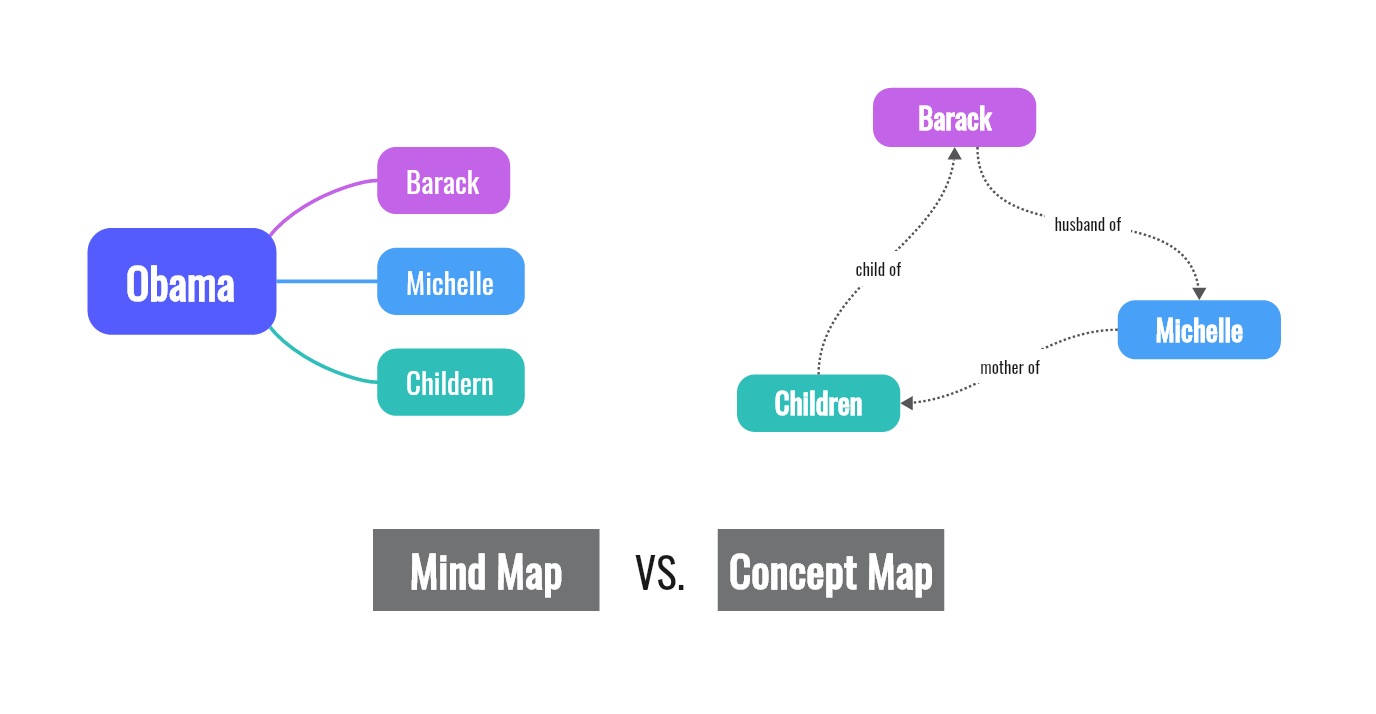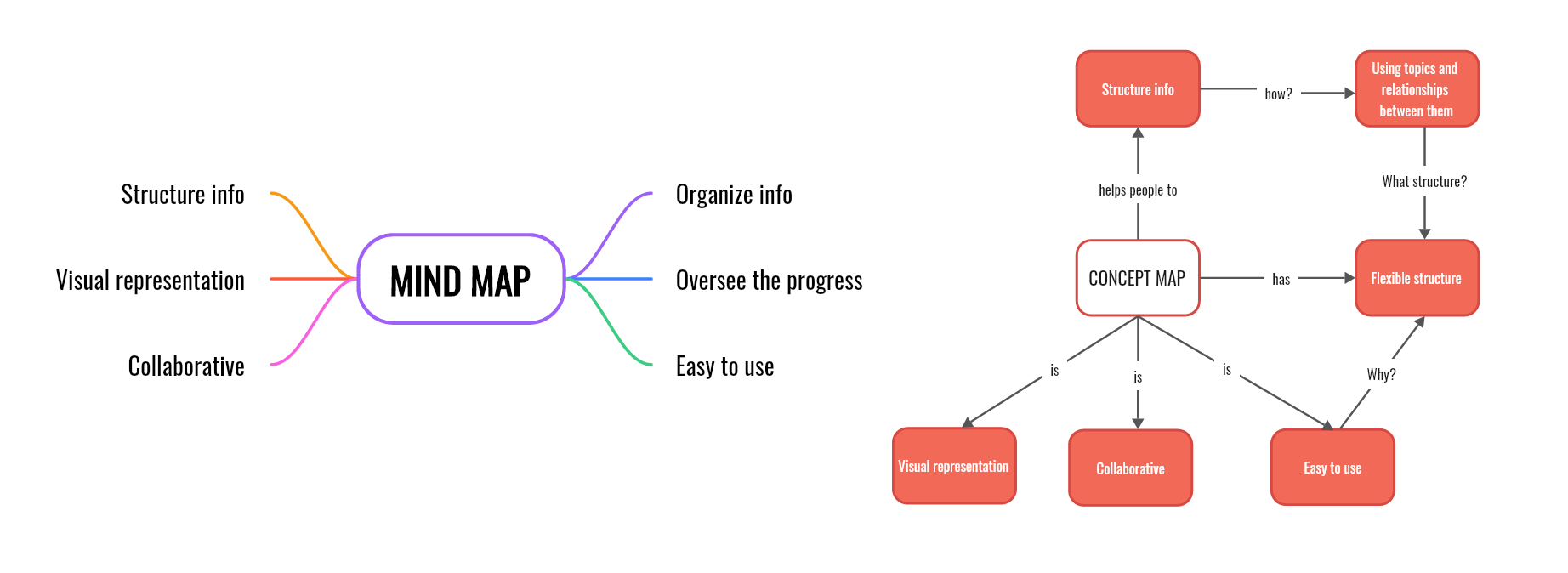There will be times when a mind map and a concept map get mixed up, especially if one does not know the difference between the two. While they might both be diagrams, they have distinct differences, which you must learn to use the suitable template moving forward.
This article will comprehensively explain the difference between mind map and concept map templates and how to use them. Continue reading to learn more.

What is a mind map?
A mind map is a visual tool used for higher levels of brainstorming. It lets you structure your to-dos or analyze various issues in one board. Generally, the diagram considers one side of an issue or problem, thus giving only a single layer of information. While developing your mind map through diagramming software, you customize the colors and shapes and highlight the branches through different colors to represent connections between concepts.
Mind mapping is not based on any criteria or framework. This allows creators to develop these maps independently. In return, the mind mapping process activates and fosters one's brain and supports memory function. As a result, it creates the right orientation in problem-solving methods.
What is a Concept Map?
A concept map is a diagram you'll use when visualizing and displaying connections between ideas and concepts. These pieces of information are collated and categorized through different shapes. Concept mapping is an excellent assistant for one's work and creativity. It illustrates a comprehensive visualization of the concept in which all the information is classified logically.
Using the concept is also an effective way of activating one's brain to flesh out creative and innovative ideas. As you get used to using this map, you can instantly identify the root causes of the issues involved. Since the concept map promotes creativity, creators won't be restricted to numbers and texts. It also provides visualizations and highlights, making the process inspirational and interesting.
What are the differences between mind maps and concept maps?
There are areas one must look into to understand better the difference between mind map and concept map diagrams. As you know, these two vary in different aspects, even though their illustrations are different. The list below shows in what specific areas these diagrams differ.
- Mind mapping follows a radial structure, while concept mapping includes three structures with several branches and networks.
- Another thing to look into when assessing the difference between mind map and concept map templates is the ideas they focus on. A mind map focuses on a single idea, while concept maps magnify multiple concepts.
- You can determine the difference between mind map and concept diagrams by how the diagram is created. It might require you to have thinking skills to structure concept maps. Meanwhile, developing a mind map is spontaneous and fast.
- As previously mentioned, a mind map is more flexible. In contrast, concept maps involve more logical processes and keep a hierarchical structure.
- Connection words. A concept map includes connection words that are aligned through arrows, while mind maps do not contain such.
- Another distinct difference between mind map and concept map templates is that it's easy to change mind maps even after creating them. However, it might be challenging to modify a concept map due to its nodes.

Which one should you choose?
Despite knowing the difference between mind map and concept map diagrams, some may get confused about which one they should use. It might be fitting to look into three vital elements before deciding which to choose. See the list below.
Content
The creation of mind maps primarily revolves around the strategy of memorization and personalized note-taking. Its effectiveness as a learning and study technique lies in the intricate, personalized structure it offers, coupled with the rapid-box diagram style, which significantly enhances recall. The adaptability of mind maps renders them invaluable in educational settings. For instance, educators can employ mind maps to elucidate complex topics to students, formulate comprehensive lesson plans, and craft effective revision guides, demonstrating their versatility in the classroom.
As you already know, developing a concept map can be more rigorous than mind maps. With concept mapping, ideas are generally linked through linking texts, and your maps don't have unexplained connections. Overall, a concept map visualizes systems, which is something tree-like diagrams of a mind map can't easily do.
If you are about to present content that aims to share knowledge with people not initially part of the map creation, then you use the concept map. The map can describe systems that heavily rely on interactions, illustrate sequences and processes, and visualize subjects.
Audience
When deciding between a concept map and a mind map, it's crucial to consider your audience's characteristics, including their educational background and age group. Mind maps typically prove ideal for academic settings and a wide range of age groups. They are versatile tools suitable for activities such as creating book summaries, taking notes, making to-do lists, studying, and facilitating brainstorming sessions. On the other hand, concept maps find their niche in business meetings, structuring HTML pages, conducting in-depth analyses, organizing courses and projects, and enhancing the study of complex subjects, showcasing their effectiveness in various professional contexts.
Usability
Additionally, it's valuable to define your specific needs before selecting between these diagram types. Consider whether your objective requires a straightforward, easily structured, or highly readable representation. By answering these questions, you can effectively pinpoint the most suitable choice for your intended purpose.
Conclusion
Mind maps and concept maps are both diagrams that are mostly interchanged. However, as you can see, they have varying techniques when organizing information and have their distinctive functions. To summarize, a mind map focuses on one concept, while a concept map looks into various ideas. More importantly, choosing which techniques to use is just a matter of context. You can use mind or concept maps without considering the audience, content, and usability factors.
Once you have decided which between these two, remember that an online diagramming tool will be an efficient option to develop these maps; in most cases, these software have pre-designed templates you can use. They allow you to edit and customize mind and concept maps based on your preferences and requirements. Most importantly, you can share these diagrams with your peers through a unique link.








